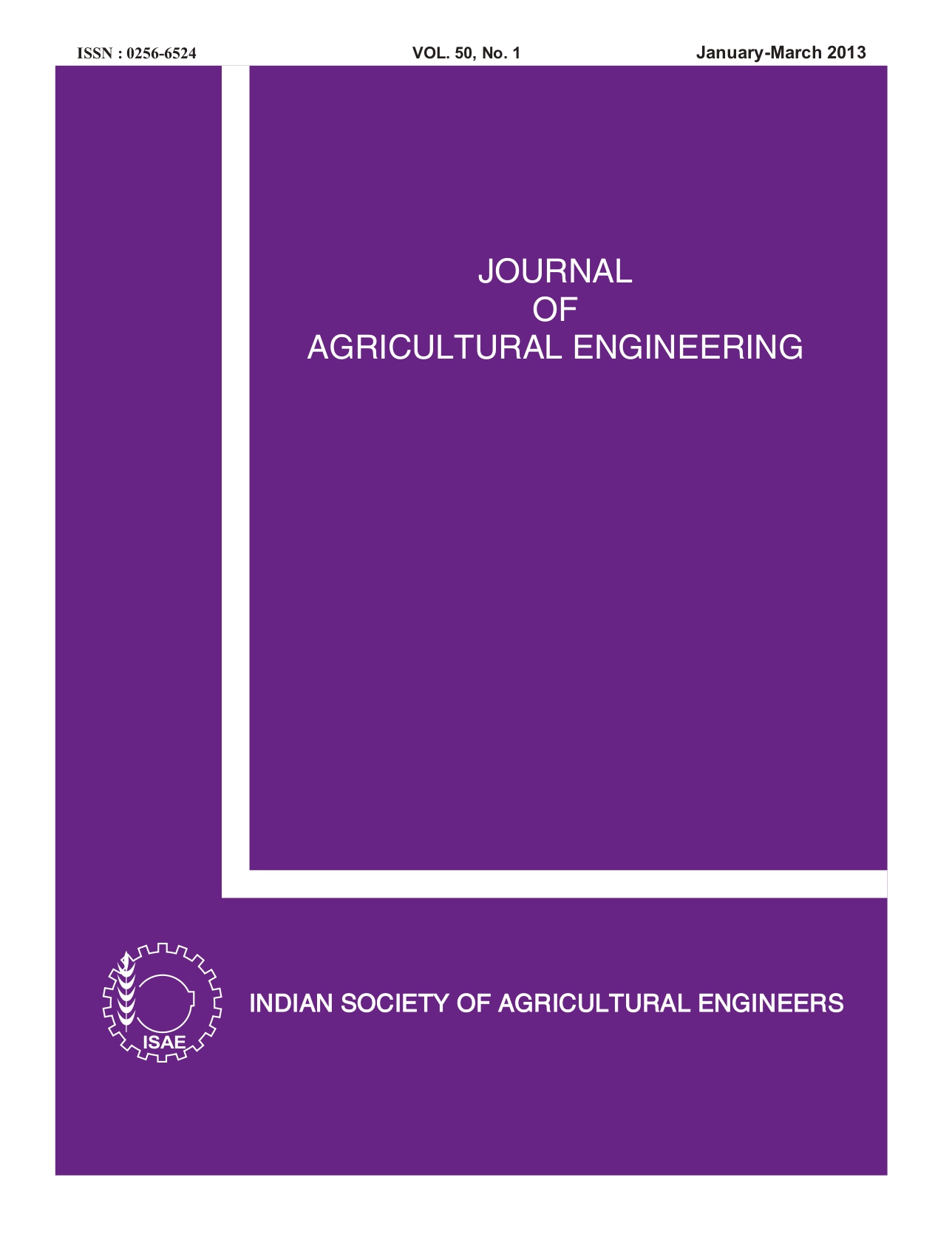Water Use Efficiency of Salt Tolerant and Non-Tolerant Wheat Varieties under Irrigated Saline Regimes
DOI:
https://doi.org/10.52151/jae2013501.1504Keywords:
Saline irrigation, salt budget, salt tolerant variety, wheat, water use efficiencyAbstract
Enhancing productivity from irrigated saline environment is of paramount importance to meet the increasing food demand in India. An experiment was conducted during rabi seasons of 2009-10 and 2010-11 with different irrigation water salinity levels and four wheat varieties, including 3 salt tolerant and one non-salt-tolerant.The yield of nonsalt tolerant variety HD-2894 irrigated with ground water (EC 1.7 dS.m-1) was highest (5.25 t.ha-1) with WUE of 18.62 kg.ha-1.mm-1. The salt tolerant variety KRL-1-4, however, produced highest yield of 4.6 t.ha-1, 4.2 t.ha-1 and 3.9 t.ha-1at irrigation water salinity levels of 4, 8 and 12 dS.m-1, respectively, during rabi 2010-11 with average yield higher by 26% and 41% as compared to non-salt tolerant variety HD2894 at irrigation water salinity levels 8 and 12 dS.m-1, respectively.The average water use efficiency of KRL-1-4 under salinity levels of 4, 8 and12 dS.m-1was 12.51 and 15kg.ha-1.mm-1 as compared to 8.75 and 10.33 kg.ha-1.mm-1 for the non-salt tolerant variety during 2009- 10 and 2010-11, respectively. Highest deposition of salt was at the top 15cm soil depth ranging from 1.21 t.ha-1in ground water irrigated plot to 6.22 t.ha-1 in plots with salinity level of 12 dS.m-1. About 66% of salt got deposited in the root zone depth up to 75cm during the crop growth period. It emerged that as the salinity of irrigation water increases, a switchover from high yielding non-salt-tolerant variety to a salt tolerant variety is desirable to achieve higher yields and higher water use efficiencies.
References
Anon. 2009.Status Paper on Wheatin India. Directorate of Wheat Development, Department of Agriculture & Co-Operation, Krishi Bhawan, New Delhi, India.
Chauhan C P S; Singh RB; Gupta SK. 2008. Supplemental irrigation of wheat with saline water. Agric.Water Manage.,95, 253-258.
Datta K K; Sharma V P; Sharma D P. 1998. Estimation of a production function for wheat under saline conditions. Agric. Water Manage., 36, 85–94.
FAO .1992. The use of saline waters for crop production, Irrigation and drainage.Paper 48, Rome, Italy.
Ghane E; Feizi M; Mostafazadeh-Fard B; Landi E. 2009. Water productivity of winter wheat in different irrigation/planting methods with the use of saline irrigation water. Int.J. Agric. Biol., 11, 131–137.
Hamdy A; Sardo V; Ghanem K A F. 2005. Saline water in supplemental irrigation of wheat and barley under rainfed agriculture. Agric. Water Manage., 78, 122–127.
Jiang J; Huo Z; Feng S; Zhang C.2012.Effect of irrigation amount and water salinity on water consumption and water productivity of spring wheat in Northwest China. Field Crops Research, 37, 78–88.
Kalra N; Chakraborty D; Kumar P R; Jolly M; Sharma P K. 2007. An approach to bridging yield gaps, combining response to water and other resource inputs for wheat in northern India, using research trials and farmers’ fields data. Agric. Water Manage., 93, 54-64.
Khosla B K; Gupta R K. 1997. Response of wheat to saline irrigation and drainage. Agric. Water Manage., 32, 285–291.
Ma W; Mao Z; Yu Z; Mensvoor M E F; Driessen P M. 2008. Effects of saline water irrigation on soil salinity and
yield of winter wheat–maize in North China Plain. Irrigation and Drainage Systems, 22,3–18.
Michael A M. 2010. Irrigation, Theory and Practice. 2ndEdition. Vikas Publishing House Pvt Ltd., 518-526.
Minhas P S.1996. Saline water management for irrigation in India, Agric. Water Manage., 30, 1-24.
Naresh R K; Minhas P S; Goyal A K; Chauhan C P S; Gupta R K. 1993.Conjunctive use of saline and non-saline
waters. II. Field comparison of cyclic use and mixing for wheat. Agric. Water Manage., 23, 139–148.
Nia H S; Zarea M J; Rejali F; Varma A. 2012. Yield and yield components of wheat as affected by salinity and
inoculation with Azospirillum strains from saline or nonsaline soil, J. Saudi Society of Agric. Sci., 11, 113–121.
Sharma D E; Singh K N; Rao K V G K; Kumbhare P S. 1991. Irrigation of wheat with saline drainage water on a sandy loam soil. Agric. Water Manage., 19, 223–233.
Sharma D P; Rao K VGK. 1998.Strategy for long term use of saline drainage water for irrigation in semi-arid regions. Soil Tillage Res., 48, 287-295.
Sharma B R; Minhas P S. 2005.Strategies for managing saline/alkali watersfor sustainable agricultural production in South Asia. Agric. Water Manage., 78, 136-151.
Singh R; Van Dam J C; Feddes R A. 2006.Water productivity analysis of irrigated crops in Sirsa district,
India. Agric. Water Manage., 82, 253 – 278.














